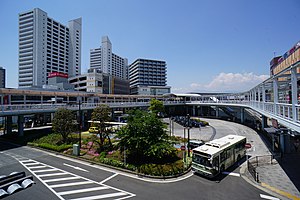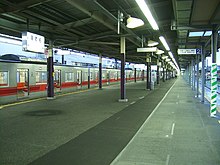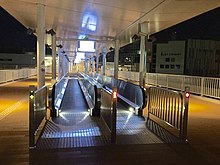Ebina train station
| Ebina ( 海 老 名 ) | |
|---|---|
|
Station section Odakyū / Sōtetsu (May 2017)
|
|
| Data | |
| Location in the network | Connecting station |
| Design |
Through station / terminus station |
| Platform tracks | 8th |
| abbreviation | OH32 / SO18 |
| opening | November 25, 1941 |
| location | |
| City / municipality | Ebina |
| prefecture | Kanagawa |
| Country | Japan |
| Coordinates | 35 ° 27 '12 " N , 139 ° 23' 25" E |
| Height ( SO ) | 22 m TP |
| Railway lines | |
| List of train stations in Japan | |
The Ebina Station ( Jap. 海老名駅 , Ebina-eki ) is a train station on the Japanese island of Honshu . It is a major transportation hub and is located in Kanagawa Prefecture in the Ebina City area . It is developed by one line each from the Odakyū Dentetsu , Sagami Tetsudō and JR East railway companies .
links
Ebina comprises two operationally separate train stations, both of which have the same name. The larger train station in the east is shared by the Odakyū Dentetsu and Sagami Tetsudō railway companies . The former operates the Odakyū Odawara Line between Shinjuku and Odawara . The latter is responsible for the Sōtetsu main line , which begins in Yokohama and has its western terminus here. In terms of traffic volume, the Odawara line is the more important, although - apart from several romance car connections - all express and express trains stop here. During the day there are up to 13 trains every hour and up to 23 trains during rush hour. Local trains usually connect Shinjuku with Hon-Atsugi . Into town many trains are Yoyogi-Uehara to the Chiyoda Line of the Tokyo subway by bound . On the Sōtetsu main line up to ten local and express trains run every hour during the day, during rush hour up to 16. Most of them run to Yokohama, two or three per hour are directed via Nishiya to the Shōnan-Shinjuku line and run over Shinjuku out to Kawagoe or Ōmiya .
The smaller station in the west is served by the Sagami line of the JR East railway company, which connects Chigasaki with Hashimoto . Local trains run every 15 minutes during the morning and evening rush hour, every 20 minutes during the day and every half hour late in the evening. During rush hour, individual trains run from Hachiōji to Chigasaki and back without having to change trains in Hashimoto.
In addition to its function as a railway junction, Ebina is also an important hub for bus transport. The bus station in front of the eastern train station has seven bus platforms , each with several stops. These are served by 20 lines of the companies Sōtetsu Bus and Kanagawa Chūō Kōtsū , by the Fuji Xerox factory bus , by shuttle lines to Tokyo-Haneda Airport and by night bus lines. Three other lines of Sōtetsu Bus and Kanagawa Chūō Kōtsū run to the western station. The Ebina BUSTLE bus terminal for long-distance bus services is just under half a kilometer south of the eastern train station .
investment
The station in the Megumichō district consists of two operationally separate parts, which are oriented from northeast to southwest and are a little more than 200 meters apart. They are connected by a wide covered pedestrian passage equipped with a moving walkway . There are several high-rise office buildings, leisure and cultural facilities and shopping centers between the two station buildings and around them . Particularly noteworthy are the LaLaport Ebina with more than 250 shops and the Ebina Central Park , a shopping street that extends to the east . They contribute significantly to the fact that Ebina is one of the most frequented train stations in the region.
To the east is the larger of the two train stations, which in turn is composed of two buildings built next to each other. The ground level through station of the Odawara line has four tracks on two completely covered central platforms . A spacious reception building in the form of a riding station spans over it , which is connected to the pedestrian passage, the bus station and the shopping street. A little to the north is added to the slightly higher lying terminus of Sotetsu main line, the two blunt ending tracks, each with a side platform comprises. Ebina is also an important operational center of Odakyū Dentetsu: In the south-west there is a depot with a depot , in the north-east there is an extensive parking facility with space for around 300 rail cars. The Sagami Line station in the west is much smaller. It is a ground-level through station with two tracks on a mostly uncovered central platform. The associated riding station is integrated into the pedestrian passage. Two more tracks were used for freight traffic to the Atsugi marshalling yard and are connected to the Sōtetsu main line.
In the 2018 fiscal year, an average of 291,791 passengers used the station every day. Of these, 153,713 were on the Odakyū Odawara line, 123,951 on the Sōtetsu main line and 14,127 on the Sagami line.
Tracks
- Odakyū Dentetsu
| 1/2 | ▉ Odakyū Odawara lineage | Shin-Matsuda • Odawara • Hakone-Yumoto |
| 3/4 | ▉ Odakyū Odawara lineage | Machida • Shin-Yurigaoka • Yoyogi-Uehara • Shinjuku |
- Sagami Tetsudo
| 1/2 | ▉ Sōtetsu main line | Yamato • Futamatagawa • Nishiya • Yokohama |
- JR East
| 1 | ▉ Sagami line | Atsugi • Chigasaki |
| 2 | ▉ Sagami line | Hashimoto • Hachiōji |
history
All three railway lines had existed since the 1920s. Ebina was only a small village at the time, which is why the trains initially ran through here without stopping and only stopped at Atsugi station just under two kilometers south-west . The Sagami Tetsudō opened on November 25, 1941 a new station on the Sōtetsu main line to open up the settlement, which had grown in the meantime. From April 1, 1943, trains from Odakyū Dentetsu also stopped here , especially since the Sagami Tetsudō shared the Odakyū Odawara line from here to Hon-Atsugi . Two decades later, this parallel route gradually resulted in a capacity bottleneck, which is why the Sagami Tetsudō moved its western terminus to Ebina on November 5, 1964.
From December 18, 1972, express trains operating on the Odawara Line also stopped in Ebina and on the same day the Odakyū Dentetsu put a storage facility into operation. A year later, on December 21, 1973, the station used together with the Sagami Tetsudō was moved around 400 meters to the west to its current location. The Sagami line operated by the Japanese State Railways remained unaffected by this measure, although its route is only around 200 meters away. For this reason, the city of Ebina sought to improve the transfer relationships and fully financed the construction of an additional station on the Sagami line. Its opening took place on March 21, 1987. Only eleven days later, on April 1, the new section of the station became the property of the new company JR East as part of the privatization of the state railway .
After Odakyū Dentetsu and Sagami Tetsudō had signed an agreement to this effect in January 2006, extensive renovation of the older part of the station began three years later. The reasons for this were the increased requirements, especially with regard to accessibility, and heavy congestion, especially during rush hour. The work included widening the overpass, a new counter hall on the east side, a railway police station and the installation of escalators and elevators. They were completed in August 2010. The overpass was then extended to the Sagami line station. Linked to this is an important urban renewal project on the wasteland between the two parts of the station.
Adjacent train stations
|
←
|
Lines |
→
|
||
|---|---|---|---|---|
| Zama |
Odakyū Dentetsu |
Atsugi | ||
| Kashiwadai |
Sagami Tetsudō |
The End | ||
| Iriya |
|
Atsugi | ||
Web links
- Station information of Odakyū Dentetsu (Japanese)
- Sagami Tetsudō Station Information (Japanese)
- JR East Station Information (Japanese)
Individual evidence
- ↑ Weekday schedule to Shinjuku. Odakyū Dentetsu , 2020, accessed April 12, 2020 (Japanese).
- ↑ Weekday schedule in the direction of Yokohama. Sagami Tetsudō , 2020, accessed April 12, 2020 (Japanese).
- ↑ JR 時刻表 2019 年 3 月 号 (JR timetable March 2019). Kōtsū shinbunsha, Tokyo 2019.
- ↑ 鉄 道 部門 : 1 日 平均 駅 別 乗 降 人員. Odakyū Dentetsu , 2018, accessed April 12, 2020 (Japanese).
- ↑ 1 日 平均 各 駅 乗 降 人員. (PDF, 32 kB) Sagami Tetsudō , 2018, accessed on April 12, 2020 (Japanese).
- ↑ 各 駅 の 乗車 人員. JR East , 2018, accessed April 12, 2020 (Japanese).
- ↑ Shigetoshi Shibata: 日本 の 私 鉄 13 相 模 鉄 道 . Hoikusha, Osaka 1980, pp. 149-151 .
- ^ Tetsudō Journal, Volume 21, No. 6. Tetsudōjānarusha, Tokyo May 1987. p. 104.
- ↑ Tetsu Ishino (Ed.): 停車場 変 遷 大事 典 国 鉄 ・ JR 編 (station change directory JNR / JR) . JTB, Tokyo 1998, ISBN 978-4-533-02980-6 .





